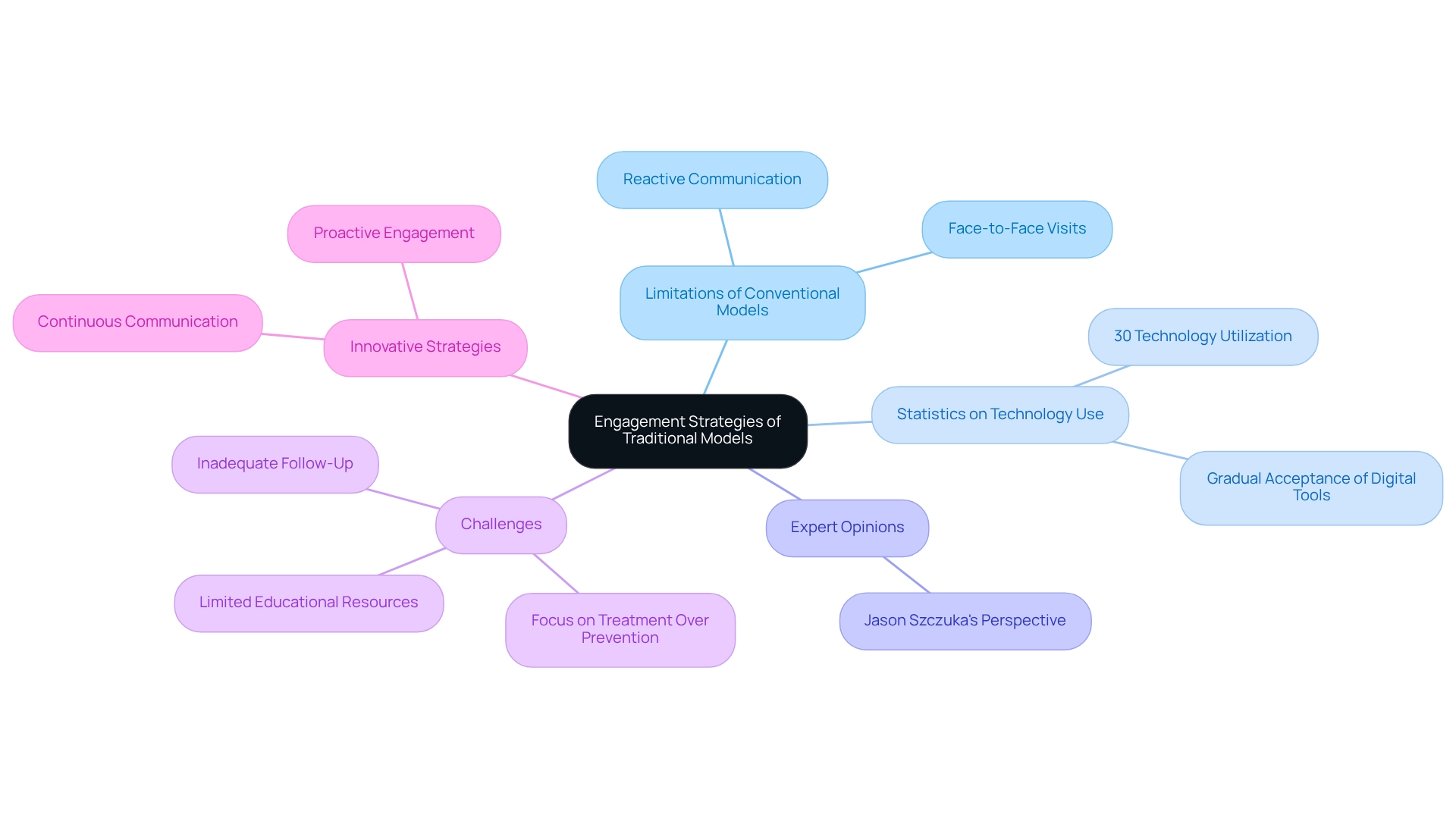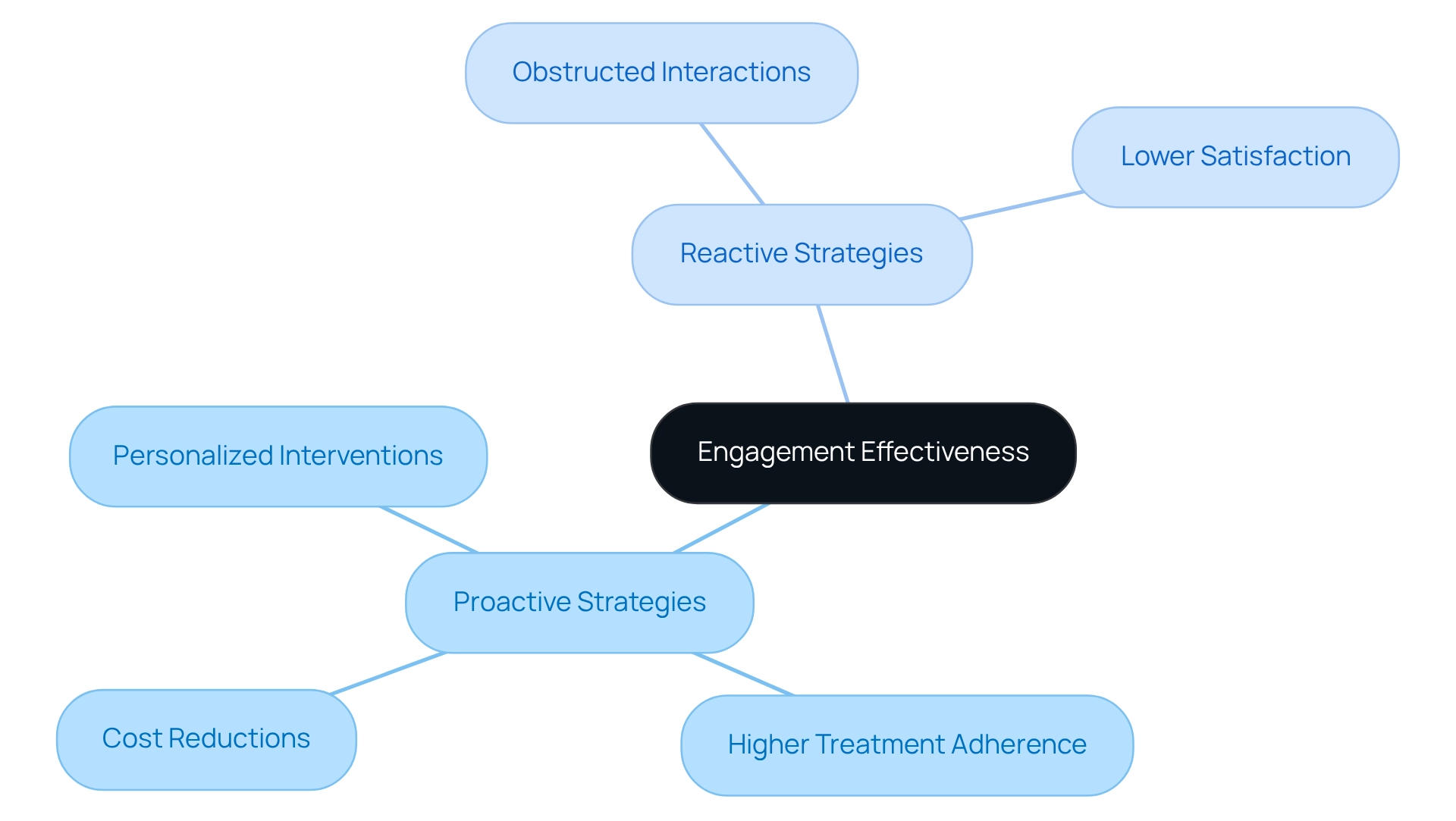Overview
The article provides a compelling comparison of the engagement strategies employed by healthcare payers versus traditional models. It highlights that healthcare payers leverage proactive, data-driven approaches, which not only lead to higher member satisfaction but also improve health outcomes. This assertion is substantiated by evidence indicating that healthcare payers can tailor interventions based on comprehensive data insights. In contrast, traditional models frequently depend on reactive strategies that restrict patient involvement and support, ultimately limiting their effectiveness. This difference underscores the importance of adopting innovative engagement methods in the healthcare sector.
Introduction
In the intricate landscape of healthcare, grasping the roles of payers and traditional models is vital for enhancing patient engagement and care delivery. Healthcare payers, encompassing government programs like Medicare and private insurers, are increasingly transitioning from fee-for-service models—focused on volume—to value-based care approaches that prioritize quality and patient satisfaction.
As these organizations embrace innovative, data-driven strategies to boost member engagement, the stark contrast with traditional models, often marked by reactive communication and limited outreach, becomes evident.
This article examines the evolving engagement strategies utilized by healthcare payers alongside traditional models, underscoring the profound influence of data insights and technology on patient outcomes and satisfaction in an ever-evolving healthcare environment.
Defining Healthcare Payers and Traditional Models
Healthcare-payers are organizations responsible for financing or reimbursing health services, which include government programs such as Medicare and Medicaid, as well as private insurance companies. Traditional models, in contrast, typically refer to fee-for-service systems where providers receive payment for each service rendered, prioritizing volume over value. This distinction is vital as it greatly influences the development and execution of engagement strategies across various medical frameworks.
In 2025, government funding constitutes around 50% of medical expenditures, underscoring the significant role of Medicare and Medicaid in shaping recipient dynamics. Medicare Part D notably offers prescription medication coverage and necessitates enrollment in Parts A and/or B, adding complexity to the payer landscape. The transition to value-oriented treatment models, propelled by legislative modifications like the 21st Century Cures Act, fosters innovative strategies for managing individuals, particularly groups such as those with end-stage renal disease (ESRD). This act encourages participation in Medicare Advantage Plans, which increases access to at-home dialysis and enhances overall outcomes for individuals.
The distinctions between care providers and traditional fee-for-service models extend beyond financial frameworks; they also affect how care is provided and experienced by individuals. While conventional models may concentrate on the quantity of services offered, approaches that prioritize quality and client satisfaction are increasingly being embraced by healthcare-payers. Insights from CareSet’s comprehensive Medicare data reveal how providers navigate treatment pathways using ICD, NDC, and HCPCS codes, essential for understanding individual journeys from diagnosis to treatment. Providers utilize these codes to diagnose diseases, define interventions, and track individual progress through various lines of therapy, and understanding what treatments are approved by healthcare-payers such as Medicare Part D plans, along with the associated payment amounts, is critical for stakeholders. This financial insight allows for better planning and resource allocation in treatment options. As Chris Schmaltz, Chief Value-Based Care Officer, observes, these strategies promote significant transformation in management for individuals, providers, and medical systems. This evolution indicates a wider trend in the U.S. healthcare culture, emphasizing prompt access to services, which occasionally conflicts with the slower, more bureaucratic procedures linked with government-operated systems.
Comprehending these differences is essential for stakeholders in the healthcare field as they navigate the intricacies of patient involvement and service delivery in a changing environment. The case study titled ‘Putting Patients First: Unlocking Medicare Data to Empower HCP’ illustrates how utilizing Medicare data can boost provider involvement and enhance treatment alternatives, highlighting the significance of adapting to new methods of healthcare.
Engagement Strategies of Healthcare Payers
Healthcare-payers are increasingly adopting data-driven interaction strategies that emphasize personalized communication and proactive outreach, particularly through the lens of CareSet’s comprehensive Medicare data insights. By utilizing advanced analytics from CareSet, healthcare-payers can identify high-risk members and customize interventions accordingly, thereby enhancing their capability to manage services effectively. The integration of digital tools, such as mobile applications, facilitates self-service options, allowing members to access health information and services more conveniently. This not only boosts member satisfaction but also leads to improved health outcomes, as members are more inclined to engage in their health management when they have easy access to information and resources.
For instance, Wellframe reports generating an average of 34 digital touchpoints per member each month, significantly raising participation levels. This frequent interaction with healthcare-payers keeps members informed and engaged in their care, which is crucial for managing chronic conditions and improving overall health outcomes. Furthermore, the HealthEdge® Annual Payer Market Planning Report 2025 underscores the necessity for healthcare-payers to adopt modern technology to enhance accessibility and empower members to take an active role in their wellness. By leveraging CareSet’s technology and data insights, healthcare-payers can create tailored communication strategies that resonate with individual member needs, thereby improving engagement. In 2025 and beyond, the integration of innovative technologies and personalized experiences will be essential for healthcare-payers aiming to differentiate themselves in a competitive landscape. A data-driven approach that links various individual touchpoints, supported by CareSet’s insights, is crucial for enhancing the member experience, while healthcare-payers must ensure that ethical data usage and privacy compliance remain vital for successful engagement efforts.
As demonstrated in case studies on client involvement, such as a data-focused outreach initiative executed by a prominent healthcare-payer that resulted in a 20% rise in member participation in wellness programs, the importance of big data, especially from CareSet, is becoming increasingly essential. This enables healthcare-payers to cultivate community collaborations that enhance care coordination and ultimately improve health outcomes. Furthermore, addressing ethical data usage and privacy adherence is critical, as it fosters trust with members and ensures that engagement strategies are both effective and considerate of individual privacy.
Engagement Strategies of Traditional Models
Conventional medical models predominantly depend on face-to-face visits and responsive communication methods, often restricting individual involvement to scheduled appointments. This approach typically lacks proactive outreach, leaving individuals feeling unsupported in managing their health beyond clinical settings.
In 2025, statistics indicate that only a fraction of healthcare providers—approximately 30%—are utilizing technology for communication with individuals, underscoring the gradual acceptance of digital tools in enhancing interaction. This statistic highlights significant challenges in patient engagement, as many patients experience gaps in their treatment, particularly concerning preventive measures.
Expert opinions suggest that the limitations of in-person visits hinder the potential for ongoing support, emphasizing the need for more integrated and reliable communication channels. Jason Szczuka articulates, “The way I view the promise of digital health and where, as a society, we have not optimized it yet, is the extension of the actual delivery of great care in the more convenient, connected and consistent forums.”
Furthermore, challenges such as inadequate follow-up and a focus on treatment rather than prevention exacerbate these issues, resulting in a reactive rather than proactive medical experience. Examples of these responsive strategies include:
- Occasional check-ins
- Limited educational resources
These strategies fail to encourage substantial involvement from individuals. To address these deficiencies, healthcare providers must explore innovative engagement strategies that prioritize continuous communication and support from healthcare-payers, ultimately enhancing individual outcomes.
CareSet’s monthly Medicare updates provide critical insights into drug utilization, detailing which diseases are diagnosed and treated, as well as how individuals navigate their journey from diagnosis to treatment. By leveraging comprehensive data solutions, as demonstrated in the case study ‘Putting Patients First: Unlocking Medicare Data to Empower HCP,’ CareSet not only fulfills urgent data needs but also fosters long-term strategic development, thereby improving patient interaction outcomes.

Comparative Analysis of Engagement Effectiveness
A comparative analysis of involvement strategies reveals that healthcare-payers frequently achieve superior member satisfaction and health outcomes compared to traditional models. Healthcare-payers leverage proactive, data-driven approaches, such as those provided by CareSet’s comprehensive Medicare data solutions, to facilitate personalized interventions tailored to individual member needs. In contrast, traditional models often rely on reactive strategies, which can obstruct effective interaction.
For instance, studies indicate that patients participating in initiatives led by healthcare-payers demonstrate higher adherence to treatment plans and increased utilization of preventive services. This proactive involvement not only promotes better health outcomes but also aids in cost reductions.
Additionally, a recent study emphasized that the promptness of prenatal services for Medicaid HMO members reached 87.4%, exceeding the 85.8% rate for Commercial HMO, highlighting the success of strategies implemented by healthcare-payers. Furthermore, a study on low-value care utilization discovered no notable differences in the use of low-value cancer screenings or medications between Medicare Advantage and traditional Medicare beneficiaries, indicating that proactive involvement may mitigate the risks associated with low-value care.
As Mallory Magelli-McKeown pointed out, ‘The development of medical interaction strategies is essential for enhancing client results.’ As healthcare continues to evolve, the distinction between proactive and reactive engagement, supported by insights from CareSet, will play a crucial role in shaping patient experiences and outcomes.

Conclusion
The transition from traditional fee-for-service models to a value-based care approach signifies a pivotal transformation in the healthcare landscape. Recognizing the distinct roles of healthcare payers alongside the limitations of conventional models enables stakeholders to adeptly navigate the complexities of patient engagement and care delivery. Through data-driven strategies, healthcare payers are increasingly prioritizing personalized communication and proactive outreach, resulting in enhanced member satisfaction and improved health outcomes.
Conversely, traditional models often depend on reactive strategies that hinder continuous patient engagement. This underscores the pressing necessity for healthcare providers to embrace innovative engagement techniques that emphasize ongoing communication and support. Insights derived from comprehensive data solutions, such as those offered by CareSet, illustrate how leveraging data can significantly enhance patient journeys and promote better treatment outcomes.
Ultimately, the effectiveness of these engagement strategies is reflected in the superior member satisfaction and health outcomes realized by healthcare payers. As the healthcare industry continues to evolve, it is imperative to adopt these proactive, data-informed approaches to elevate patient care and ensure individuals receive the essential support throughout their healthcare journeys. The future of healthcare hinges on harnessing the power of data and technology to establish a more connected, responsive, and patient-centric system.


